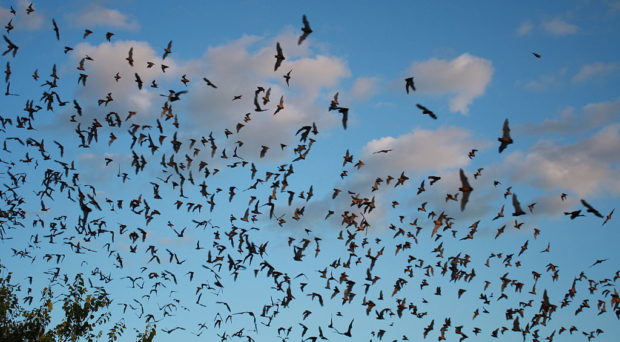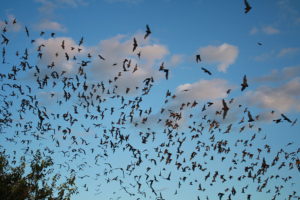
While recently attending the Society for Molecular Biology and Evolution (SMBE) conference in Austin, TX, I had the opportunity to see the famous Congress Avenue Bridge bats. Every March-November, an estimated 1.5 million Mexican free-tailed bats, fly out in almost cloud-like formation to the city of Austin for their nightly meal.
Historically, bats have had reputation problems (i.e., fear around vampire bats ‘feeding’ on humans, rabies transmission), but more recently, however, they are increasingly being appreciated for their critical role in many ecosystems, helping to curb populations of potentially damaging and dangerous insect pests (e.g. mosquitoes and those that destroy crops) and acting as pollinators for several key crops including bananas, guavas, and mangoes.
Furthermore, bats live longer than you would expect, given the amount of energy they have to expend daily and their body size, so they are being used more frequently as a mammalian model to better understand human aging.
It is therefore not surprising that there has been increased interest in studying bats, and somewhat appropriately, studies involving bats featured prominently at SMBE. What follows is a summary of some of the key papers/posters that were presented at the meeting—specifically on the topic of longevity in bats. Many of these come from Emma Teeling’s Molecular Evolution and Mammalian Phylogenetics team at University College Dublin, who are explicitly involved in studying aging mechanisms in bats.
Emma Teeling’s ‘Comparative genomics of bats: the secret of extended longevity?’ examines how longevity in bats might be linked to their ability to prevent or repair damage caused to cells and DNA by free radicals and immunity to resistance to viral diseases (i.e., rabies, SARS, Ebola, and others). Teeling reviews her current investigations surrounding the possibility of a genomic basis for their immunity and resulting longevity. She initiated a long-term research project tracking the aging of bats over time, sampling their blood so they can examine potential molecular changes over time and compare to other mammalian populations. The research is on-going, and you can visit their lab web page to check on the latest progress.

‘The role of telomeres in the evolution of exceptional longevity in bats’ by Nicole Foley and colleagues, examines how certain maintenance genes (which are linked to aging in mammalian species) were highly expressed in many bat species, leading researchers to speculate that these maintenance genes help mitigate the common effects of aging in bats. Understanding this process could also have implications for understanding and influencing the human aging process and even cancer treatment.
David Jebb and colleagues looked at the role of mitochondrial mutational load, or MML, in the exceptional longevity of bats. The Free-Radical Theory of Aging (FRTA) postulates that the accumulation of free radicals in cells results in aging. According to this theory, increases in MML are associated with mutations resulting from damage by free radicals, and are thereby linked to aging. Because of a bat’s exceptional longevity, researchers wanted to compare their MML level to those of aging humans. They found that these levels were comparable to both other bats and to humans, but that in bats, mutations involving flight and longevity were favored.
Lastly, Graham Hughes and colleagues asked ‘Is there a link between aging and microbiome diversity in exceptional mammalian longevity?’. They examined the gut bacteria of juvenile and adult bats as a potential source for insights into bat longevity. Interestingly, they found no dramatic shift in the abundance and types of gut bacteria between the younger and older bats (which challenges the results of similar studies in other mammal species which found differences). An analysis of the bacteria revealed that these particular bacteria are implicated in mechanisms related to metabolism, DNA repair, energy consumption, flight and aging.
While the underlying mechanisms responsible for bats essentially defying longevity rules (i.e.,a small mammal with demanding energy requirements living for 20+ years) are not yet fully understood, fascinating progress is being made which will hopefully someday reveal exactly the mechanisms at work that account for this remarkable longevity and how these translate to other mammalian species, including humans.
- Placental Sex Differences: Q&A with Amy Inkster - 9th September 2019
- Transposon Day Quiz: 2019 - 10th June 2019
- World Penguin Day quiz - 24th April 2019
Comments